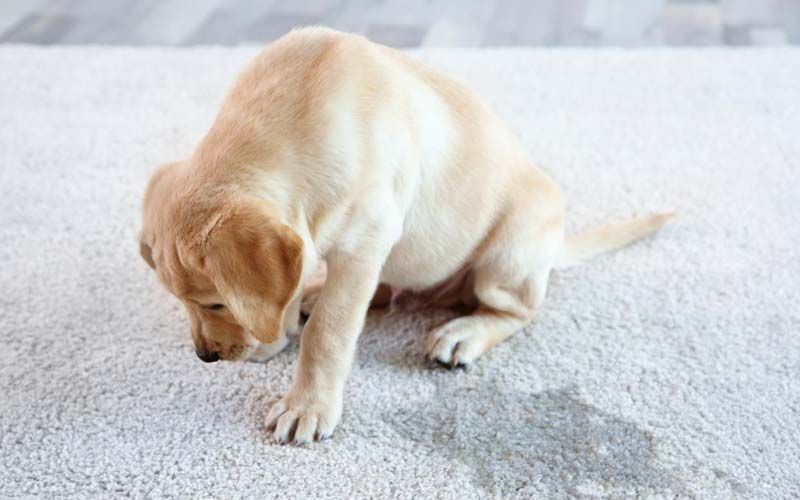Has your dog ever greeted someone with an unexpected puddle on the floor? While this behavior can be puzzling and frustrating, it’s actually quite common in dogs. Whether it’s a specific friend, family member, or even a stranger, some dogs react to certain individuals by urinating—often out of excitement, submission, or anxiety.

Understanding the reasons behind this can help you better manage the situation and support your dog in overcoming this behavior. In this article, we’ll explore the common causes, from emotional triggers to potential medical issues, and provide practical steps to help your dog stay calm and confident when meeting people.
1. Understanding the Behavior
Excitement Urination
Excitement urination is common in young dogs, especially puppies, who may urinate when overwhelmed by positive emotions. When a dog becomes overly excited to see someone they love or associate with fun activities, such as playtime, they may lose control of their bladder. This type of urination is often involuntary and can occur in situations where the dog feels a burst of joy or energy.
Signs to look for include tail wagging, jumping, and general hyperactivity, all happening in conjunction with urination. The key here is that the dog is not fearful but simply overexcited. Excitement urination tends to decrease as dogs mature and can be managed through training and calm interactions.
Submissive Urination
Submissive urination is different from excitement urination; it occurs when a dog urinates to show submission, often to someone they perceive as more dominant. This behavior is typically linked to feelings of insecurity or fear, and the dog uses urination as a way to communicate their submission, hoping to avoid conflict.
Triggers for submissive urination can include past reprimands, harsh body language, or even a certain tone of voice. Dogs may also exhibit this behavior if they feel intimidated by the presence of a specific person. It’s important to recognize that the dog isn’t being disobedient; they are responding to perceived dominance.
Anxiety and Fear Responses
Anxiety and fear can also cause dogs to urinate when they see certain people. If a dog has had a negative interaction with someone or is naturally anxious around unfamiliar individuals, they may lose bladder control as part of their stress response. This type of urination is typically accompanied by other signs of anxiety, such as cowering, tail tucking, or avoidance.
Common scenarios might include meeting someone who previously frightened the dog or encountering a new person who the dog finds intimidating.

2. Medical Considerations
While excitement, submission, or anxiety are often the reasons behind a dog urinating when they see a certain person, it’s important not to overlook potential medical causes. Conditions such as urinary tract infections (UTIs), bladder stones, or incontinence could also be contributing to the behavior. These issues can cause a dog to lose control of their bladder, resulting in accidents that may be mistaken for emotional responses.
If your dog’s urination behavior suddenly appears or worsens without any clear emotional trigger, it’s essential to consult a veterinarian. A medical evaluation can rule out any underlying health problems and ensure your dog receives the appropriate treatment.
Symptoms that may indicate a medical issue include:
- Frequent urination or accidents
- Straining or difficulty urinating
- Blood in the urine
- Excessive licking of the genital area
- Changes in drinking habits (increased or decreased water intake)
Addressing medical conditions early can prevent the problem from escalating and ensure your dog stays healthy. If any of these signs are present, a vet visit should be your first step.

3. How to Manage Excitement Urination
Managing excitement urination involves helping your dog stay calm during greetings. By making small adjustments to your approach, you can reduce the chances of accidental urination.
Step 1: Calm Greetings
The first step to managing excitement urination is to minimize excitement during greetings. High-energy welcomes with loud voices, exaggerated gestures, or sudden movements can overwhelm a dog, triggering excitement and loss of bladder control. Instead, keep greetings calm and low-key. When you or someone else enters the room, avoid direct eye contact and speak in a calm, soft voice. Wait until the dog is relaxed before offering attention.
Tip: Teach guests or family members to follow the same approach, as consistency is key in training your dog to stay composed during greetings.
Step 2: Encourage Calm Behavior
One effective way to reduce excitement is to encourage calm behavior with commands like “sit” or “stay.” When the dog greets someone, instruct them to sit before they are allowed any interaction. This creates a routine that shifts the dog’s focus away from their excitement and toward following a command.
Reward calm behavior with treats or praise. Reinforcing positive habits helps the dog associate relaxed greetings with rewards, making them more likely to stay calm in the future.
Step 3: Gradual Desensitization
If your dog struggles with excitement when meeting certain people, desensitization can help. Have the person approach the dog slowly and calmly over time, gradually getting closer in repeated sessions. The goal is to help your dog get used to the person’s presence without overwhelming excitement. Start with short interactions, and as your dog remains calm, extend the time and level of engagement.
This gradual exposure reduces the intensity of the dog’s emotional response, allowing them to greet people without losing control of their bladder. Over time, with patience and consistency, excitement urination can significantly diminish.

4. Addressing Submissive Urination
Submissive urination is a behavior often triggered by insecurity or fear, and helping your dog overcome this issue requires patience and a focus on building their confidence.
Step 1: Build Confidence
To reduce submissive urination, it’s crucial to build your dog’s confidence. Use positive reinforcement to reward desirable behaviors, helping your dog feel secure and less anxious. Avoid using intimidating body language, such as standing over the dog, direct eye contact, or loud commands, which can intensify their feelings of submission. Instead, crouch down to their level, speak softly, and offer treats or praise when they respond positively. By reinforcing calm and confident behavior, you help your dog feel more in control.
Tip: Confidence-building exercises, such as obedience training or agility courses, can also boost your dog’s self-assurance over time.
Step 2: Avoid Punishment
One of the biggest mistakes when dealing with submissive urination is scolding or punishing the dog. This can make the problem worse, as the dog may become more fearful, leading to increased submissive urination. Remember, the dog is not being disobedient—they are reacting out of fear or a desire to avoid conflict. Punishing them reinforces their belief that they are in danger, further weakening their confidence.
Instead of reprimanding, focus on redirecting the dog’s attention and rewarding them when they exhibit calm, confident behavior.
Step 3: Train with Respect
Using calm, respectful training methods is essential in fostering a trusting relationship with your dog. Practice gentle, assertive commands that encourage cooperation without inducing fear. For example, instead of forcefully commanding your dog to sit, guide them through the process using a soft tone and patience. Gradually, your dog will learn to respond to your cues without feeling the need to show submission.
Training with respect helps create a secure environment where your dog feels safe and confident. This sense of security reduces the likelihood of submissive urination and strengthens the bond between you and your dog.

5. Reducing Anxiety Around Certain People
Imagine a dog named Bella who always seemed nervous around her owner’s brother, Tom. Every time Tom came over, Bella would cower, avoid eye contact, and even have little accidents. This behavior wasn’t because Bella didn’t like Tom; it was because she associated his presence with anxiety. To help Bella, her owner began a two-step process to reframe how Bella perceived Tom.
Step 1: Positive Association
The first step was creating positive experiences between Bella and Tom. Each time Tom visited, he would calmly approach Bella with treats and affection. Instead of overwhelming her with attention, he let her come to him at her own pace, offering a small treat each time she showed calm curiosity. Over time, Bella began associating Tom with good things—yummy treats and gentle affection—slowly helping to shift her perception from fear to trust.
Step 2: Consistency and Patience
The transformation didn’t happen overnight. Bella’s owner and Tom had to stay consistent in their approach. Every visit, they repeated the same calm, positive interactions, never rushing or forcing Bella into uncomfortable situations. Their patience paid off as Bella’s anxiety gradually lessened, and she started greeting Tom with a wagging tail instead of nervous behavior.
By focusing on positive association and being patient and consistent, Bella’s owner was able to help her overcome her fear, proving that with time and the right approach, anxious behavior can be reduced effectively.

Final Thoughts
Understanding why your dog urinates when seeing certain people is crucial in addressing the behavior effectively. By recognizing the underlying causes—whether they be excitement, submission, or anxiety—you can approach the situation with empathy and patience. Implementing strategies to manage these behaviors, such as creating positive associations and encouraging calm interactions, can significantly improve your dog’s confidence and comfort.
If the issue persists or worsens despite your efforts, don’t hesitate to seek professional help from a veterinarian or a certified dog trainer. Remember, with time, consistency, and the right training methods, most dogs can overcome this behavior and build healthier relationships with the people around them. Your commitment to understanding and supporting your furry friend will ultimately lead to a happier and more confident companion.